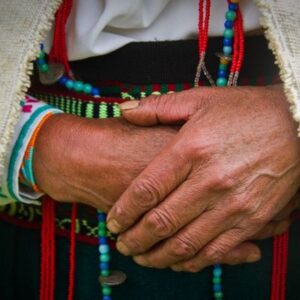
Suicide is an issue that all communities face, but some populations have much higher rates than others. Indigenous communities are an example. For decades in the U.S., Indigenous populations have disproportionally high rates of suicide compared to other populations. [1] However, this isn’t only happening in the U.S. In Canada, First Nations people, Métis, and Inuit all have significantly higher suicide rates than non-Indigenous people. [2] The same is true for First Nations people in Australia, with suicide rates being more than three times higher than non-Indigenous populations. [3]
Why are Indigenous populations across the globe at a greater risk of suicide than non-Indigenous populations? Historically, Indigenous communities have been overlooked when it comes to research and funding. Indigenous groups make up around 6% of the world’s population [4] and approximately 2% of the population in the U.S. [5] Even though they’re small, these communities are incredibly important.
Mental health challenges can affect everyone. However, Indigenous populations face unique struggles. This contributes to significantly higher rates of suicide among Indigenous people. These disparities are rooted in a complex history of colonization, cultural erasure, discrimination, and generational trauma. Addressing suicide, then, is not only a matter of public health. It is also an essential step toward finding healing and creating equity for Indigenous peoples everywhere.
Who are Indigenous Peoples?
Indigenous peoples are identified as those who inhabited a land long before other groups from other cultures settled there. These communities have their own rich histories and cultures, including their own languages and beliefs. They have strong ties to the land itself and deep knowledge of the natural world. Many Indigenous communities are also self-governing. In the U.S. alone, 574 different American Indian tribes and Alaska Native entities are recognized. [6]
Causes of Suicide: Poverty and Other Factors
Suicide is a complex issue. It can be caused by a variety of factors. Indigenous populations have their own set of unique challenges. Many of these challenges are tied to their history of oppression. Because these challenges are unique to this population, it can be difficult for Indigenous communities. They struggle to get the attention they need. Understanding and assistance are often elusive for them.
One of the most prominent issues is poverty. Based on the 2018 U.S. Census data, Indigenous people had the highest rate of poverty among all minority groups, with 25.4% living in poverty. [7] In 2022, poverty levels rose specifically for American Indian and Alaska Native children, with 25.9% living in poverty. [8] Poverty can have ripple effects, leading to lack of healthcare and the issue of substance use.
- Lack of healthcare access
Many Indigenous communities have limited access to healthcare services. This is due to a variety of factors, ranging from unemployment to racial discrimination to limited access to transportation. Because of this, Indigenous people are more likely to suffer from health issues that many of the general population are able to more easily prevent. For example, over 50% of Indigenous people worldwide over age 35 have type 2 diabetes. [9] They also are more likely to experience cardiovascular illnesses. [10] Living with health challenges can be isolating, physically uncomfortable, and may lead to depression and risk of suicide.
- Substance use
Just like the lack of general healthcare access, Indigenous communities also have limited access to resources for substance use treatment. In the U.S., substance use among Indigenous people is much greater than that of the general population. The 2018 National Survey on Drug Use and Health (NSDUH) found that 10% of Native Americans have a substance use disorder and 7.1% have an alcohol use disorder. [11] It also found that nearly 25% of Native Americans reported binge drinking in the past month. [12] Again, much of this is due to a lack of available treatment options. There is also a lack of transportation services. Both of these issues stem from the problem of poverty. Studies report that over 50% of all suicides are associated with drugs or alcohol. [13]
Additionally, there are other cultural and historical factors that play into negative mental health outcomes and suicide risk.
- Stigma around mental health
While steps have been made in many areas to reduce mental health stigma, certain populations still hold tight to certain beliefs related to mental health issues. This makes it difficult for those struggling to feel safe and accepted if they reach out for help. According to the American Psychiatric Association, many Native American people experience some type of stigma around seeking out mental health care services. [14] They may be afraid that admitting they need help makes them appear weak or that this will bring shame upon their families or communities. - Generational trauma
One of the big issues affecting many Indigenous people is generational trauma. Generational trauma happens when one or more people experience something traumatic and pass the trauma down to further generations. The affected person often learns an unhealthy coping mechanism that their children are inevitably taught. This is one way that abuse gets passed down from generation to generation. Because Indigenous communities have historically faced oppression, displacement, and other forms of mistreatment, it has led to these cycles of generational trauma. These cycles can be difficult to break and often have a lasting impact on people’s mental health. - Violence
Domestic violence is another prevalent issue among Indigenous communities. Over 84% of American Indian and Alaska Native women experience some form of violence in their lifetime. More than 50% experience sexual violence. [15] Violence can happen for a number of reasons. It can be the result of unresolved generational trauma as well as the result of drug or alcohol abuse. No matter the cause, it can have lasting, damaging effects on a person’s mental and emotional well-being.
Approaching Prevention: A Community Effort
Tackling a multi-faceted issue such as suicide requires more than just a singular approach. Helping Indigenous communities feel supported and have access to quality, culturally appropriate care requires many avenues of change. Here are a few steps to start the momentum of prevention.
- Promote cultural revitalization
Prioritizing and celebrating Indigenous cultures is a critical starting point for healing. Many communities carry deep pain from past events. This includes being displaced from their land. It also involves having key components of their cultures erased. By reconnecting with traditional languages, spiritual practices, and ancestral knowledge, Indigenous cultures can gain strength, identity, and build stronger communities. When community members are empowered to reclaim and celebrate their cultural heritage, it can restore pride, resilience, and hope in who they are. - Elevate Indigenous voices
Along with promoting cultural revitalization, it’s also crucial to find ways to help elevate the voices of Indigenous communities. This includes making decisions that affect their own land. It also involves telling their own stories. Examples of ways to help elevate the voices of Indigenous communities include providing opportunities for them to share their knowledge. It is also important to support them in sharing their history and opinions. Funding various Indigenous organizations and advocating for land back initiatives can also be a step towards healing. While it doesn’t change the pain and trauma from the past, it’s another way to strengthen these communities and show that they matter and are important. When people know they matter, it can set them up for a successful future. - Foster youth empowerment
Helping the next generation find strength and freedom is another way to begin breaking the cycle of pain. When Indigenous youth are given meaningful opportunities to lead and engage fully with their culture, they grow in their confidence, resilience, and form a stronger sense of identity. Empowerment programs that focus on leadership development, mentorship, education, and cultural engagement help youth feel valued and give them a sense of hope for their futures. These initiatives also foster community connection and generational healing, as young people become active participants in preserving and revitalizing their heritage. By investing in youth empowerment, communities create pathways of hope, resilience, and self-determination that can break cycles of despair and promote long-term well-being.
- Provide appropriate mental health services
Accessible, culturally appropriate mental health services are incredibly important. These services can provide support for individuals struggling with depression and anxiety. They also assist those dealing with substance use and suicidal thoughts. These issues are often rooted in historical oppression and systemic racism. Additionally, they are linked to the erosion of cultural identity. It’s important to be aware, though, that addressing complex issues such as generational and communal trauma involves specific care targeted toward specific populations. The CAMS Framework® has been successful in helping those in marginalized communities, including Indigenous populations, who experience suicidal ideation. Culturally appropriate mental health services, including peer support programs and community-based healing initiatives, can offer therapeutic support while helping to restore dignity, connection, and hope.
Current Resources for Indigenous Suicide Prevention
These are a few current resources and initiatives that have been working to make a difference in the lives of Indigenous people who are struggling with suicide.
- Center for Native American Youth (Aspen Institute)
This is a national education and advocacy organization that works with Native youth ages 24 and under on reservations, in rural villages, and in cities all across the U.S. - Zero Suicide in Indian Country
Zero Suicide is a framework of suicide-specific care that is used in a wide range of behavioral healthcare systems. This resource uses the Zero Suicide framework tailored specifically to Indigenous populations and their unique needs. - Celebrating Life (Center for Indigenous Health)
Funded by the National Institutes of Health (NIH), Celebrating Life was created to support individuals of the White Mountain Apache Tribe struggling with suicide through a partnership with John Hopkins Center for Indigenous Health. This program has seen incredible success, including a 38% decrease of death by suicide. [16] - Qungasvik Toolbox
The Qungasvik Toolbox was created by Yup’ik Alaska Native communities to help youth who are struggling with alcohol abuse and suicidal ideation. It engages elders, parents, and other adults, helping create a safe space for healing while helping youth be engaged in their culture.
Addressing suicide in Indigenous populations is not a small task. It demands long-term commitment to listening, understanding, and helping create systemic change. By acknowledging both the historical and present-day injustices, we can better understand how they have shaped mental health outcomes in these communities. This recognition allows us to create spaces that honor cultural resilience. Additionally, we can support holistic healing. This means investing in culturally appropriate mental health services, empowering and elevating Indigenous voices, and promoting community-led initiatives. Most importantly, it means recognizing that healing is possible when we come together, lift up those who are hurting, and celebrate their important role in our world.
Sources:
[1] https://www.cdc.gov/suicide/facts/data.html
[2] https://www150.statcan.gc.ca/n1/pub/99-011-x/99-011-x2019001-eng.htm
[3] https://www.aihw.gov.au/suicide-self-harm-monitoring/population-groups/first-nations-people
[4] https://www.worldbank.org/en/topic/Indigenouspeoples
[5] https://iwgia.org/en/usa.html
[6] https://www.usa.gov/tribes
[7] https://ncrc.org/racial-wealth-snapshot-native-americans
[9] https://www.un.org/development/desa/Indigenouspeoples/mandated-areas1/
[10] https://www.un.org/development/desa/Indigenouspeoples/mandated-areas1/
[11] https://americanaddictioncenters.org/rehab-guide/addiction-statistics-demographics/native-americans
[12] https://americanaddictioncenters.org/rehab-guide/addiction-statistics-demographics/native-americans
[13] https://pubmed.ncbi.nlm.nih.gov/1932152/
[14] https://www.mcleanhospital.org/essential/native-american-mh
[15] https://www.ncai.org/section/vawa/overview/key-statistics
[16] https://pmc.ncbi.nlm.nih.gov/articles/PMC5105000/
